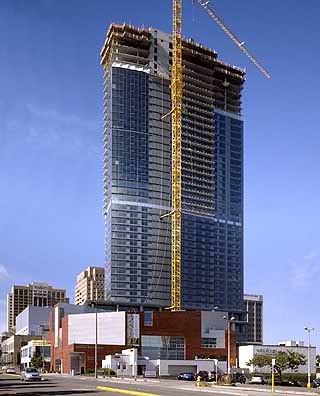
Special Applications Technical Merit

Lincoln Square hotel and condominium tower
Location: Bellevue
Owner/developer:Kemper Development Co.
Project team: Skanska USA Building, general and concrete contractor; Sclater Partners Architects, architect; ABKJ, structural engineer; Cadman, ready-mix supplier
The $220 million Lincoln Square project has a 42-story cast-in-place concrete hotel/condo tower with five below-grade levels of cast-in-place concrete garage. The 450-foot-tall tower reportedly is the tallest building in Bellevue and the tallest concrete tower on the West Coast using cast-in-place concrete framing core walls.
The parking garage and plaza level framing used 45,000 cubic yards of concrete and the tower slabs and walls used another 30,000.
The tower’s concrete framing uses post-tensioned flat plate floor slabs and two central cores. Some of the advantages of that system include: cost-effective framing; high resistance of lateral seismic and wind forces; higher ductility than conventional shear walls or steel-braced systems; $1 million in savings over other systems; elimination of perimeter beams for unobstructed views on every floor; excellent sound dampening and floor stiffness; and lower interior finish costs because soffits are exposed surfaces.
On the garage level, concrete framing created savings by not needing fireproofing.
The project was put together quicker, thanks to Skanska using the column-hung forming system.
The column-hung system’s equipment eliminates the need for re-shoring that traditional forming systems require, which can slow a project by closing off floors to trades or storage due to load considerations. With the column-hung system, workers have almost immediate access to lower areas of the building while concrete slabs are being set, poured and stripped on the floors above.
The result is a nearly 30 percent increase in productivity for deck construction and a significant decrease in labor costs.